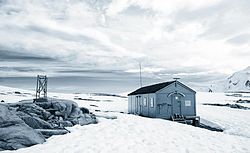Damoy Point: Difference between revisions
Created page with '{{Infobox NT |name=Damoy Point |territory=British Antarctic Territory |island=Wiencke Island |picture=Damoy Point Hut (Station L) Wiencke Island.jpg |latitude=64° 49′ S |longi…' |
No edit summary |
||
| Line 4: | Line 4: | ||
|island=Wiencke Island | |island=Wiencke Island | ||
|picture=Damoy Point Hut (Station L) Wiencke Island.jpg | |picture=Damoy Point Hut (Station L) Wiencke Island.jpg | ||
|latitude= | |latitude=-64.8167 | ||
|longitude= | |longitude=-63.5167 | ||
}} | }} | ||
'''Damoy Point''' is on Dorian Bay, on [[Wiencke Island]] off [[Graham Land]] in the [[British Antarctic Territory]]. Here stands the Damoy Point Refuge, which was last occupied in 1993 and is no looked after by the [[United Kingdom Antarctic Heritage Trust|UK Antarctic Heritage Trust]] | '''Damoy Point''' is on Dorian Bay, on [[Wiencke Island]] off [[Graham Land]] in the [[British Antarctic Territory]]. Here stands the Damoy Point Refuge, which was last occupied in 1993 and is no looked after by the [[United Kingdom Antarctic Heritage Trust|UK Antarctic Heritage Trust]] | ||
Latest revision as of 19:30, 30 July 2014
| Damoy Point | |
|
| |
|---|---|

| |
| Location: | 64°49’0"S, 63°31’0"W |
| Information | |
Damoy Point is on Dorian Bay, on Wiencke Island off Graham Land in the British Antarctic Territory. Here stands the Damoy Point Refuge, which was last occupied in 1993 and is no looked after by the UK Antarctic Heritage Trust
The hut which served as the Damoy Point Refuse was build in 1973 and it was used for a number of years as a British summer air facility and a transit station for scientific personnel. A 400m ski-way was marked out along the spine of the glacier on which a Twin Otter aircraft was able to land. The hut was used each year to enable personnel and stores arriving by ship to be flown on to Rothera Research Station on Adelaide Island, which was especially important in the early summer when sea ice would otherwise prevent direct access to Rothera by sea.
The hut was last occupied in 1993 and was designated a Historic Site and Monument in 2009. External decoration works were undertaken by a work party from the UK Antarctic Heritage Trust during the 2009/2010 season and the 2010/2011 season.
The site consists of a well-preserved hut and the scientific equipment and other artefacts inside it, with an estimated 500 artefacts on site.
